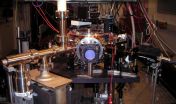(Press-News.org) One of the striking features of self-organization in biomolecular systems is the capacity of assemblies of filamentous particles for synchronous motion. Physicists of Ludwig-Maximilians-Universitaet (LMU) in Munich now provide new insights into how such movements are coordinated.
Living matter, which consists largely of diverse polymeric structures assembled from various types of subunits, often exhibits striking behaviors, such as a capacity for self-organization and active motion. On an organismic scale, this type of collective motion is exemplified by the synchronous motions of flocks of starlings or geese, but it is also observed at the level of bacterial and animal cells. Physicists are interested in teasing out the elementary mechanisms that underlie the formation of such ordered structures and organized motions, with a view to gaining a deeper understanding of macroscopic phenomena. Dr. Christoph Weber and Professor Erwin Frey, who holds the Chair of Biological and Statistical Physics at LMU Munich, in collaboration with Dr. Ryo Suzuki and Professor Andreas Bausch at the Technical University of Munich (TUM), have chosen a model system based on filaments made up of subunits of the protein actin for their investigations. Actin microfilaments are involved in the active migration of nucleated cells and in intracellular transport processes. In their experiments the researchers first immobilize motor proteins by fixing them to a glass slide. When actin filaments were added together with a source of biochemical energy, they interacted with the motors and exhibited active gliding motions. Moreover, individual filaments were found to locally adopt strongly curved configurations, and the team analyzed their statistics, what happens when filaments collide and under what conditions interacting filaments exhibit collective, streaming motions. Their latest results appear in the journals Nature Physics and PNAS.
According to the most popular theory, the fact that thin actin filaments bend as they are propelled by motor proteins is attributable to random thermal fluctuations, i.e. Brownian motion. But this assumption is false, says Christoph Weber, who now works at the Max-Planck-Institute for the Physics of Complex Systems in Dresden. Brownian motion has only a very weak impact on the form of the filaments. Instead, as the Munich researchers show, the molecular motors are not only responsible for propelling the fibers, they also cause them to form strong bends. "The filaments exhibit a range of local curvatures, the statistical distribution of which is incompatible with thermally driven motion," Ryo Suzuki explains.
The role of non-binary interactions
In addition, the researchers have shown that the assumption that the interactions in the system are always binary in nature is not sufficient to explain the fact that, at high densities, filaments can align with each other and begin to display directed, collective motions. In fact, simultaneous encounters involving multiple agents appear to be required to account for the emergence of such collective motion. In this case, the filaments, each of which is composed of multiple subunits, apparently remain in stable alignment with each other and interact not only pairwise, but also in a non-binary manner. In their experiments, the scientists observed that, depending on the density and the mean length of the filaments, a phase transition occurs in which a state of non-directed movements is abruptly transformed into one characterized by collective motions ('swarm formation'). Furthermore, this transition resembles the condensation of a gas into the liquid state, except that in this case, it is not the pattern of microscopic molecular motions that changes but the orientation of the molecules in the system.
From a theoretical point of view, this implies that the currently favored model for the motions of actively driven particles, which is based on the kinetic theory of gases, cannot adequately account for the behavior of such systems. Instead, it appears as if the filaments themselves act in a coordinated fashion, like molecules in a fluid state. "To understand how collective motion arises in these systems, we need to develop new theoretical concepts which go beyond the assumptions of the kinetic theory of gases," says Erwin Frey, whose work is supported by the Nanosystems Initiative Munich (NIM), a Cluster of Excellence. Exactly what happens at the microscopic level when filaments come into alignment, i.e. how their subunits interact with neighbors or exchange places, is not yet clear. At all events, a better understanding of the physics of actively propelled systems would permit scientists to construct entirely novel nanosystems that display collective behaviors.
INFORMATION:
PROVIDENCE, R.I. [Brown University] -- Old dogs can teach humans new things about evolution. In Nature Communications a new study of North American dog fossils as old as 40 million years suggests that the evolutionary path of whole groups of predators can be a direct consequence of climate change.
"It's reinforcing the idea that predators may be as directly sensitive to climate and habitat as herbivores," said Christine Janis, professor of ecology and evolutionary biology at Brown University, who worked with lead author Borja Figueirido, a former Brown Fulbright postdoctoral ...
Most of the debate around e-cigarettes has focused on the developed world, but the devices are becoming more widely available in some low- and middle-income countries, where there is even greater potential for impact on public health, say two Stanford University School of Medicine researchers.
"People don't think e-cigarettes will reach the developing world. But they are already being produced in developing countries, and they are cheap. People know they are available," said Andrew Chang, MD, a resident in internal medicine who focuses on global health.
Chang and Michele ...
Among high school students in Los Angeles, those who had ever used electronic cigarettes were more likely to report initiation of smokable ("combustible") tobacco (such as cigarettes, cigars, and hookah) use over the next year compared with nonusers, according to a study in the August 18 issue of JAMA.
Combustible tobacco, which has well-known health consequences, has long been the most common nicotine-delivering product used. Electronic cigarettes (e-cigarettes), which are devices that deliver inhaled aerosol usually containing nicotine, are becoming increasingly popular, ...
Among overweight and obese patients with type 2 diabetes, daily injection of the diabetes drug liraglutide with a modified insulin pen device, in addition to diet and exercise, resulted in greater weight loss over 56 weeks compared with placebo, according to a study in the August 18 issue of JAMA.
Obesity is a chronic disease and a significant global health challenge. Weight loss is recommended for patients with type 2 diabetes. Moderate weight loss (5 percent-10 percent) can improve glycemic control and other cardiometabolic risk factors and disorders. Weight loss is ...
Among patients with active cancer and acute symptomatic venous thromboembolism (VTE; blood clots in the deep veins), the use of the low molecular-weight heparin tinzaparin daily for 6 months compared with warfarin did not significantly reduce recurrent VTE and was not associated with reductions in overall death or major bleeding, but was associated with a lower rate of clinically relevant nonmajor bleeding, according to a study in the August 18 issue of JAMA.
Venous thromboembolism is a major cause of illness and death in patients with cancer. Treatment with low-molecular-weight ...
Scientists from the University of Sheffield have discovered MRI scanners, normally used to produce images, can steer cell-based, tumour busting therapies to specific target sites in the body.
Magnetic resonance imaging (MRI) scanners have been used since the 1980s to take detailed images inside the body - helping doctors to make a medical diagnosis and investigate the staging of a disease.
An international team of researchers, led by Dr Munitta Muthana from the University of Sheffield's Department of Oncology, have now found MRI scanners can non-invasively steer cells, ...
Women giving birth after undergoing fertility treatment face an increased risk of depression compared to women ending up not having a child following fertility treatment, according to new research from the University of Copenhagen. According to the researchers, this has key implications for fertility treatment in future.
Danish researchers are among the first worldwide to study the risk of developing a clinical depression for women undergoing fertility treatment. The new study shows that women who give birth after receiving fertility treatment are five times more likely ...
Tropical Depression 11E came to an end early today, Tuesday, August 18 when the National Hurricane Center noted that the storm degenerated into a remnant low pressure area. NOAA's GOES-West satellite caught an infrared image of the fizzling system.
At 5 a.m. EDT (2 a.m. PDT/0900 UTC) the National Hurricane Center (NHC) issued the final bulletin on Post-Tropical depression 11E. At that time, the center of Post-Tropical cyclone 11E was located near latitude 24.9 North and longitude 125.6 West. It had fizzled about 1,000 miles (1,610 km) west of the southern tip of Baja ...
Researchers from Ludwig-Maximilians-Universitaet (LMU) in Munich have used computed microtomography (micro-CT) to identify to the species level an exceptionally wellpreserved fossil arthropod from the famous Chengjiang Lagerstätte in China.
Modern imaging methods make it possible to perform detailed, non-invasive studies on the internal structures of irreplaceable fossil specimens. Researchers led by Dr. Yu Liu of LMU's Department of Biology II now demonstrate the power of this approach by using computed microtomography (micro-CT) to investigate a specimen recovered ...
Researchers from the University of Southampton have demonstrated for the first time a new laser cooling method, based upon the interference of matter waves, that could be used to cool molecules.
Our ability to produce samples of ultra-cold atoms has revolutionised experimental atomic physics, giving us devices from atomic clocks (the core of GPS) and enabling a range of quantum devices, including the possibility of a quantum computer.
However, the current technique of cooling atoms down from room temperature to the ultra-cold regime using optical molasses (the preferential ...


